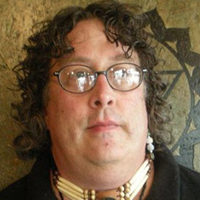
It feels like a full circle to be reviewing a movie in which a fellow Oklahoman, friend, and tribal member stars. Knowing some of the back-door story to an amazing journey for Richard Ray Whitman (Yuchi, Muscogee), I was pleased to see the actor in the recently released Neither Wolf Nor Dog.
The crowdfunded 110-minute film was shot in just 18 days in South Dakota. It is a perfect example of community-based support and internet marketing, which is indicative of the Native ways, using community.
The guerrilla film-making technique works for Scottish director Steven Lewis Simpson, and is a fine artistic vehicle for Richard Ray Whitman. Depicting the author’s eccentric journey into the Lakota lands and spirituality, it is based on the book by Kent Nerburn, and adapted by both author and director.
Nerburn (Christopher Sweeney) is called in by Dan, a Lakota elder, who wants him to write about his life and that of his people. Nerburn’s bumbling false start opens up a dialogue on how a non-Native sees Native culture. “You must first listen before you can see,” Dan tells the white writer. Grover (Richard Ray Whitman) plays the oft believable Native cynic, and Nerburn’s antagonist.
Nerburn is forced reluctantly into a road trip, in an authentic “N’dn”—a jalopy normally held together by bailing wire—all the while learning to hear first. Dan and Grover try their best to embolden Nerburn to see and write the story in his own way. And to do so without falling prey to white men’s guilt-ridden clichés of glorifying an indigenous race.
Dan is played by veteran actor Chief Dave Bald Eagle in an honest but very traditional way. At times a viewer gets lost in his portrayal as if we are there in the scene with him. Many of Dan’s and Grover’s lines are hidden gems of truth embedded within their dialogue. Such as: “Welcome to our land, promises made to the dead. Just ghosts of broken dreams,” or “Just ’cuz it’s written doesn’t make it truth.”
Unfurling before you is the majesty of the Lakota land, with an unvarnished portrayal of Native people. During this journey, we see Nerburn’s awakening. In the cafe scene with folks drinking coffee, a modern tragic scene is believably played. Amidst the truth that sometimes addiction robs so much from so many, the solidarity of family is also seen.
Richard Ray Whitman delivers his best, solidly conveying authority in a leading role. The rawness of his anger plays well upon Sweeney’s Nerburn. The unity of actors and script, with an able director, is skillfully realized.
For me personally, seeing Richard up on the screen revealed a migration in his cumulative art and life. He studied at the Institute of American Indian Arts in Santa Fe, N.M., and was at Wounded Knee in 1973. His Street Chiefs series is internationally known. I remember sitting in his house during my college days and can still hear him say, “Man, why can’t I get roles like that?” He has now!
The climax of the film, shot at the site of the Wounded Knee Massacre, is most poignant. The scene lingers long after in both heart and mind. It was rumored that, tossing the script aside, Chief Dave Bald Eagle extemporized this scene. Sadly, he died not long after filming this movie.
This low-budget yet esthetic film must be seen and heard. It’s a gate that swings open to a splendid human vista. The trailer can be viewed here.










